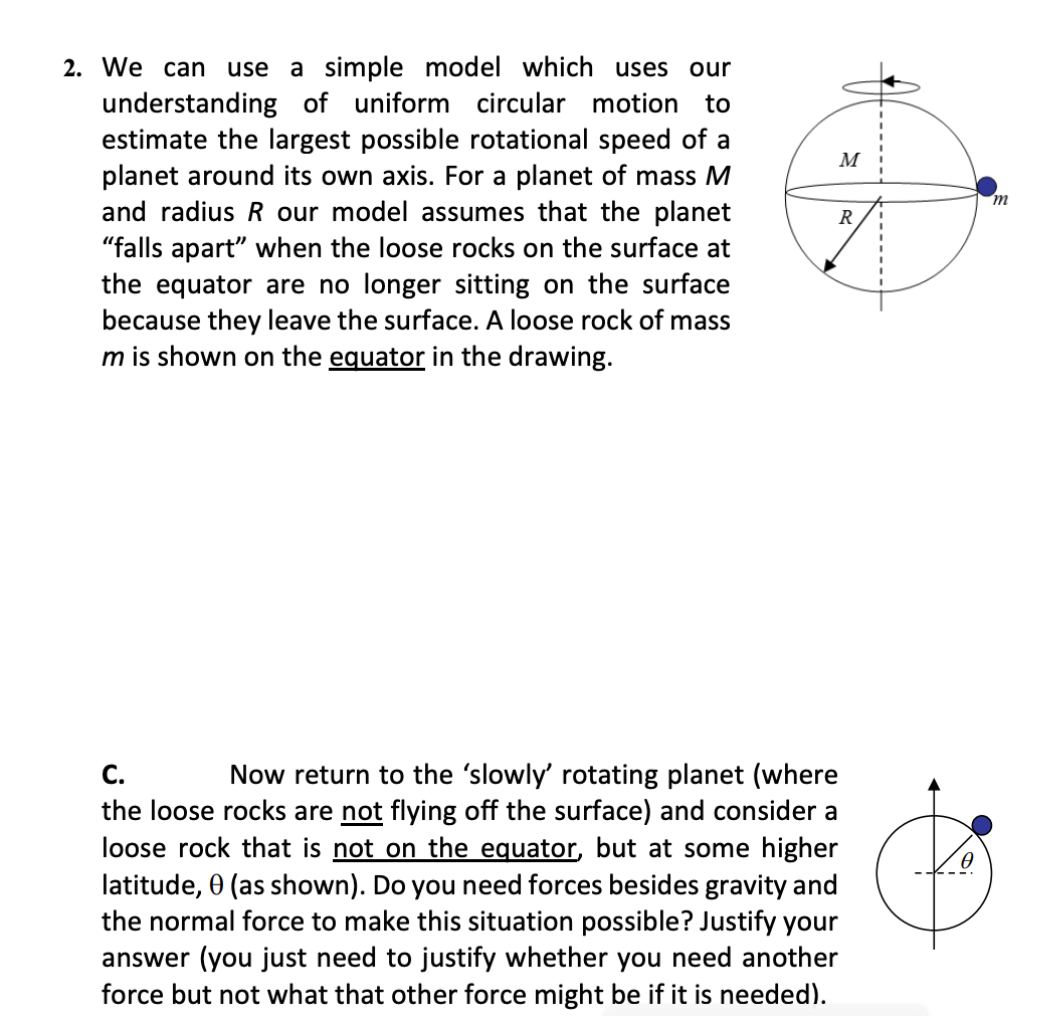2. We can use a simple model which uses our understanding of uniform circular motion to estimate the largest possible rotational speed of a planet around its own axis. For a planet of mass M and radius R our model assumes that the planet "falls apart" when the loose rocks on the surface at the equator are no longer sitting on the surface because they leave the surface. A loose rock of mass m is shown on the equator in the drawing. M m. R Now return to the 'slowly' rotating planet (where the loose rocks are not flying off the surface) and consider a loose rock that is not on the equator, but at some higher latitude, 0 (as shown). Do you need forces besides gravity and the normal force to make this situation possible? Justify your answer (you just need to justify whether you need another force but not what that other force might be if it is needed). С. -------
2. We can use a simple model which uses our understanding of uniform circular motion to estimate the largest possible rotational speed of a planet around its own axis. For a planet of mass M and radius R our model assumes that the planet "falls apart" when the loose rocks on the surface at the equator are no longer sitting on the surface because they leave the surface. A loose rock of mass m is shown on the equator in the drawing. M m. R Now return to the 'slowly' rotating planet (where the loose rocks are not flying off the surface) and consider a loose rock that is not on the equator, but at some higher latitude, 0 (as shown). Do you need forces besides gravity and the normal force to make this situation possible? Justify your answer (you just need to justify whether you need another force but not what that other force might be if it is needed). С. -------
College Physics
1st Edition
ISBN:9781938168000
Author:Paul Peter Urone, Roger Hinrichs
Publisher:Paul Peter Urone, Roger Hinrichs
Chapter6: Uniform Circular Motion And Gravitation
Section: Chapter Questions
Problem 16PE: Olympic ice skaters are able to spin at about 5 rev/s. (a) What is their angular velocity in radians...
Related questions
Question

Transcribed Image Text:2. We can use a simple model which uses our
understanding of uniform circular motion to
estimate the largest possible rotational speed of a
planet around its own axis. For a planet of mass M
and radius R our model assumes that the planet
"falls apart" when the loose rocks on the surface at
the equator are no longer sitting on the surface
because they leave the surface. A loose rock of mass
m is shown on the equator in the drawing.
M
m
R
С.
Now return to the 'slowly' rotating planet (where
the loose rocks are not flying off the surface) and consider a
loose rock that is not on the equator, but at some higher
latitude, 0 (as shown). Do you need forces besides gravity and
the normal force to make this situation possible? Justify your
answer (you just need to justify whether you need another
force but not what that other force might be if it is needed).
Expert Solution
This question has been solved!
Explore an expertly crafted, step-by-step solution for a thorough understanding of key concepts.
This is a popular solution!
Trending now
This is a popular solution!
Step by step
Solved in 3 steps with 3 images

Knowledge Booster
Learn more about
Need a deep-dive on the concept behind this application? Look no further. Learn more about this topic, physics and related others by exploring similar questions and additional content below.Recommended textbooks for you

College Physics
Physics
ISBN:
9781938168000
Author:
Paul Peter Urone, Roger Hinrichs
Publisher:
OpenStax College

Physics for Scientists and Engineers: Foundations…
Physics
ISBN:
9781133939146
Author:
Katz, Debora M.
Publisher:
Cengage Learning

College Physics
Physics
ISBN:
9781305952300
Author:
Raymond A. Serway, Chris Vuille
Publisher:
Cengage Learning

College Physics
Physics
ISBN:
9781938168000
Author:
Paul Peter Urone, Roger Hinrichs
Publisher:
OpenStax College

Physics for Scientists and Engineers: Foundations…
Physics
ISBN:
9781133939146
Author:
Katz, Debora M.
Publisher:
Cengage Learning

College Physics
Physics
ISBN:
9781305952300
Author:
Raymond A. Serway, Chris Vuille
Publisher:
Cengage Learning

Glencoe Physics: Principles and Problems, Student…
Physics
ISBN:
9780078807213
Author:
Paul W. Zitzewitz
Publisher:
Glencoe/McGraw-Hill

University Physics Volume 1
Physics
ISBN:
9781938168277
Author:
William Moebs, Samuel J. Ling, Jeff Sanny
Publisher:
OpenStax - Rice University

College Physics
Physics
ISBN:
9781285737027
Author:
Raymond A. Serway, Chris Vuille
Publisher:
Cengage Learning